Themed collection Computational Modelling as a Tool in Catalytic Science

Computational modelling in catalytic science
This themed collection includes a collection of articles on computational modelling in catalytic science.
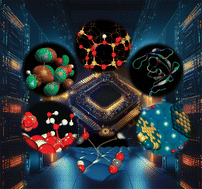
Phys. Chem. Chem. Phys., 2023,25, 20775-20776
https://doi.org/10.1039/D3CP90127K
Multiscale QM/MM modelling of catalytic systems with ChemShell
We present an overview of recent developments in the computational chemistry environment ChemShell for multiscale QM/MM modelling of biomolecular and materials catalysts, together with a survey of recent catalysis applications using ChemShell.
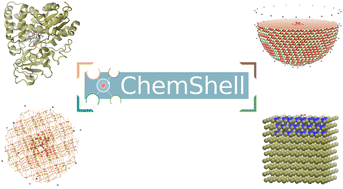
Phys. Chem. Chem. Phys., 2023,25, 21816-21835
https://doi.org/10.1039/D3CP00648D
The application of QM/MM simulations in heterogeneous catalysis
The QM/MM simulation method is applied to a range processes and systems relevant to heterogeneous catalysis, where an interplay of an extensive environment and local reactive interactions drives a process of interest through a funnel on a complex energy landscape.

Phys. Chem. Chem. Phys., 2023,25, 6562-6585
https://doi.org/10.1039/D2CP04537K
C–H functionalization of quinoline N-oxides catalyzed by Pd(II) complexes: a computational study
Pd(II)Cl2 catalysts favor the regioselective C8–H activation of quinoline N-oxides owing to the higher stability of the σ-complex, in contrast to Pd(II) acetate which favors C2–H activation.

Phys. Chem. Chem. Phys., 2023,25, 22755-22767
https://doi.org/10.1039/D3CP02445H
Adsorption, activation, and conversion of carbon dioxide on small copper–tin nanoclusters
Density functional theory calculations of the CO2 reduction on Cu–Sn clusters, isolated or supported on graphene and γ-Al2O3, show Cu2Sn2 on graphene to suppress the hydrogen evolution reaction and be highly selective towards the synthesis of formic acid.

Phys. Chem. Chem. Phys., 2023,25, 13429-13441
https://doi.org/10.1039/D3CP00477E
Efficient asymmetrical silicon–metal dimer electrocatalysts for the nitrogen reduction reaction
Based on first-principles calculations, we designed a highly effective SiM@C3N4 catalyst as the low-cost candidate for electrocatalytic ammonia synthesis.

Phys. Chem. Chem. Phys., 2023,25, 13126-13135
https://doi.org/10.1039/D2CP05959B
The peptide bond rupture mechanism in the serine proteases: an in silico study based on sequential scale models
The minimum size of a model system to study the peptide bond rupture mechanism in KLK5 is determined using three sequential scale models.
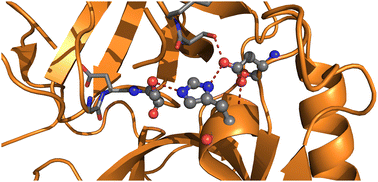
Phys. Chem. Chem. Phys., 2023,25, 8043-8049
https://doi.org/10.1039/D2CP04872H
The catalytic hydrogenolysis of compounds derived from guaiacol on the Cu (111) surface: mechanisms from DFT studies
The catalytic hydrodeoxygenation of guaiacol compounds over the Cu (111) surface was calculated to unravel the process of bio-oil upgrading.
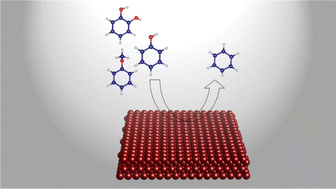
Phys. Chem. Chem. Phys., 2023,25, 6247-6252
https://doi.org/10.1039/D2CP04352A
Computational investigation of α-SiO2 surfaces as a support for Pd
Identifying the adsorption sites for Pd on the surfaces of α-SiO2.

Phys. Chem. Chem. Phys., 2023,25, 6121-6130
https://doi.org/10.1039/D2CP04722E
Large-scale benchmarks of the time-warp/graph-theoretical kinetic Monte Carlo approach for distributed on-lattice simulations of catalytic kinetics
Benchmarking the performance of an exact, massively parallel kinetic Monte Carlo implementation, towards efficient large-scale simulations of complex catalytic materials.
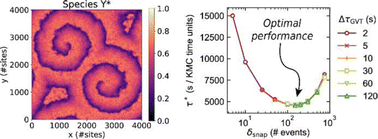
Phys. Chem. Chem. Phys., 2023,25, 5468-5478
https://doi.org/10.1039/D2CP04424B
Pt38 as a promising ethanol catalyst: a first principles study
This first-principles study predicts Pt38 nanoparticles as a promising catalyst for ethanol reactions.

Phys. Chem. Chem. Phys., 2023,25, 4649-4655
https://doi.org/10.1039/D2CP04323H
The effect of dissolved chlorides on the photocatalytic degradation properties of titania in wastewater treatment
Photocatalytic activity of titania is investigated during phenol degradation in standard water and brines. We demonstrate how solubilised chlorides can affect the hydroxyl radical formation and the photodegradation properties of titania.

Phys. Chem. Chem. Phys., 2023,25, 4161-4176
https://doi.org/10.1039/D2CP03140J
Carbon dioxide hydrogenation over the carbon-terminated niobium carbide (111) surface: a density functional theory study
Carbon dioxide (CO2) hydrogenation is an energetic process which could be made more efficient through the use of effective catalysts, e.g. transition metal carbides, such as niobium carbide.

Phys. Chem. Chem. Phys., 2023,25, 2498-2509
https://doi.org/10.1039/D2CP04749G
Untangling product selectivity on clean low index rutile TiO2 surfaces using first-principles calculations
Reactivity and selectivity of stoichiometric low-index Miller surfaces of rutile TiO2 are mapped, and the proton-coupled electron transfer mechanism of oxygen evolution is evaluated for product selectivity on each surface.

Phys. Chem. Chem. Phys., 2023,25, 2203-2211
https://doi.org/10.1039/D2CP04939B
Manipulation of N-heterocyclic carbene reactivity with practical oriented electric fields
Electric fields can be used to tune the nucleophilicity and electrophilicity of N-heterocyclic carbenes and enhance their catalytic activity.

Phys. Chem. Chem. Phys., 2023,25, 375-383
https://doi.org/10.1039/D2CP04507A
Can the isonitrile biosynthesis enzyme ScoE assist with the biosynthesis of isonitrile groups in drug molecules? A computational study
Computational studies show that the isonitrile synthesizing enzyme ScoE can catalyse the conversion of γ-Gly substituents in substrates to isonitrile. This enables efficient isonitrile substitution into target molecules such as axisonitrile-1.

Phys. Chem. Chem. Phys., 2022,24, 27250-27262
https://doi.org/10.1039/D2CP03409C
The carbon chain growth during the onset of CVD graphene formation on γ-Al2O3 is promoted by unsaturated CH2 ends
Atomistic calculations reveal the steps controlling the early stages of graphene growth on alumina, including the activation of CH4 and the formation of the reactive CH2* intermediate that couple to form linear CnH2n* (n = 2–6) and cyclic C6 species.
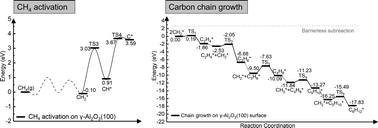
Phys. Chem. Chem. Phys., 2022,24, 23357-23366
https://doi.org/10.1039/D2CP01554D
The role of the intermediate triplet state in iron-catalyzed multi-state C–H activation
Fe-catalyzed C–H bond activation proceeds through a multi-state quintet–triplet–singlet mechanism mediated by large spin–orbit couplings (SOC). This mechanism is more favorable than the single-state quintet and two-state singlet–quintet mechanisms.
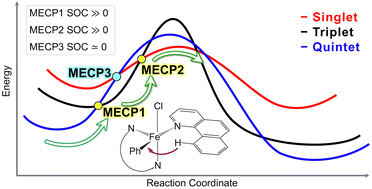
Phys. Chem. Chem. Phys., 2022,24, 20721-20727
https://doi.org/10.1039/D2CP02733J
Probing the nature of Lewis acid sites on oxide surfaces with 31P(CH3)3 NMR: a theoretical analysis
NMR 31P chemical shift can be used to define a scale of Lewis acidity of oxide surfaces.
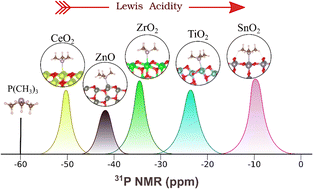
Phys. Chem. Chem. Phys., 2022,24, 19773-19782
https://doi.org/10.1039/D2CP03306B
Stereodynamics effects in grazing-incidence fast-molecule diffraction
The simulated H2 GIFMD from KCl(001) shows a strong molecular alignment dependence, revealing a puzzling stereodynamics effect in experiments.
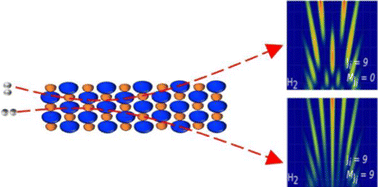
Phys. Chem. Chem. Phys., 2022,24, 19541-19551
https://doi.org/10.1039/D2CP02109A
A transferable prediction model of molecular adsorption on metals based on adsorbate and substrate properties
We present a transferable model for predicting adsorption energies to metals, based on easily computed properties of substrates and adsorbates.

Phys. Chem. Chem. Phys., 2022,24, 16545-16555
https://doi.org/10.1039/D2CP01572B
Effect of nanostructuring on the interaction of CO2 with molybdenum carbide nanoparticles
Insights of the CO2 activation and dissociation on MoCy clusters and nanoparticles are gained by first-principles calculations as a function of size and composition.

Phys. Chem. Chem. Phys., 2022,24, 16556-16565
https://doi.org/10.1039/D2CP01143C
About this collection
Computational modelling techniques now play a vital role in catalytic science. Atomic and molecular level simulation is used widely and increasingly routinely in modelling structural properties including those of the active site. Computational catalysis embraces a wide range of techniques, which at the molecular level include both static and dynamical simulations based on interatomic potentials and quantum mechanical methods using both periodic and embedded cluster techniques. The field is advancing rapidly owing to developments in technique and the continuing growth in the capability of computer hardware; and importantly it is becoming increasingly predictive with modelling guiding rather than simply explaining experiment. The articles in this issue will provide a survey of the state-of-the-art in the field. They will include technical developments but will have a strong focus on applications to real catalytic systems. They will also cover the full range of catalytic science including hetero-, homo- and bio-catalysis, illustrating how modelling and simulation now play a central role in understanding and predicting catalytic processes.
The Guest Editors are:
- Professor Richard Catlow, University College London and Cardiff University
- Dr Matthew Quesne, Cardiff University
- Dr Arunabhiram Chutia, University of Lincoln